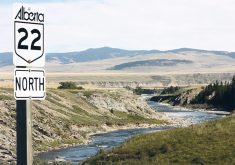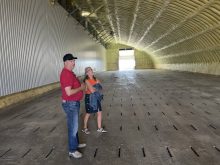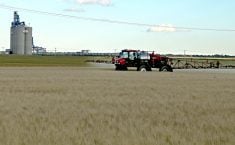A 12-year-old boy found the bones while hiking with his father this summer on the property, which is open to the public
When 12-year-old Nathan Hrushkin went on a hike with his father, Dion, this summer, he found a dinosaur.
It had been dead for 69 million years but it was a dinosaur, nevertheless.
Earlier this month Hrushkin was on the site on Nature Conservancy Canada property in Horseshoe Canyon near Drumheller, Alta., when paleontologists from the Royal Tyrell Museum collected the dinosaur bones for further study.
“I’ve been aspiring to be a paleontologist for pretty much as long as I can remember so it was really, really cool,” said Hrushkin.
Read Also

New coal mine proposal met with old concerns
A smaller version of the previously rejected Grassy Mountain coal mine project in Crowsnest Pass is back on the table, and the Livingstone Landowners Group continues to voice concerns about the environmental risks.
“I just always thought it was so cool how dinosaur bones, like the ones that we have in our bodies, end up becoming pretty much solid rock.”
Tyrell personnel have identified the bones as belonging to a hadrosaur, more commonly known as a duck-billed dinosaur.
After Hrushkin’s find, paleontologists uncovered 30 to 50 bones in the canyon wall, all of which they believe are from a single juvenile hadrosaur. Though they are among the most common fossils found in the region, “this particular specimen is noteworthy because few juvenile skeletons have been recovered and also because of its location in the strata, or the rock formation,” said an NCC news release.
“This young hadrosaur is a very important discovery because it comes from a time interval for which we know very little about what kind of dinosaurs or animals lived in Alberta. Nathan and Dion’s find will help us fill this big gap in our knowledge of dinosaur evolution,” said Francois Therrien, curator of dinosaur paleontology at Tyrell.
Hrushkin said he and his family often hike in the Drumheller area and two years ago spotted small bone fragments on the ground on a canyon trail. This year they went back to the same spot. His father said bones on the trail must have washed down from the valley walls.
“So I went up above and the bones were either sticking out of the ground or just lying on the ground right there,” said Hrushkin.
“It was very, very obvious that they were bones. They almost looked like the same bones that you would see in a cartoon or something. They were much different from the landscape around them. They really stuck out.”
It will be some time before Tyrell paleontologists extract the bones from the rock they collected and do a further analysis. By then, Hrushkin might well be on track to realize his dream of becoming a paleontologist himself.
“This has only increased my aspirations to become one.”
This is the first time a dinosaur has been found on conservancy property, said NCC Alberta communications specialist Carys Richards.
“One of the really interesting aspects, from a conservation perspective on this one, (is) when we talk about conservation, we talk a lot about the benefit to future generations. We’re always looking ahead.
“But this is just an important reminder that we need to protect land not only for the future but because it also helps us uncover our natural heritage. This is a good reminder about the mysteries of our planet’s history that can be uncovered through land conservation and by making sure that we still have access to these natural areas.”
The property involved is known as the Nodwell property, a 320-acre site donated by the family of the late Leila Nodwell, who died in 2000. Nodwell believed in preservation of the site and worked for years as an interpreter of the region’s nature and history.

The Nodwell property is open to the public and will remain so, said Richards. There is an established trail network that people are expected to use, as opposed to randomly hiking in search of further fossils.
But that will be tempting, she agreed.
“I grew up here in Alberta and I used to come to Horseshoe Canyon as a kid and hike around and I always dreamed about one day finding a dinosaur fossil. How exciting that would be. So I think that a lot of people that have been in this area before will be able to relate to this story because this is something that every kid that comes to this area probably dreams about.”
Given the collective public experience since the start of the pandemic, Richards said she hopes that Hrushkin’s story encourages more people to explore the outdoors.
“I hope it does. I hope this encourages people to get out and check out this amazing landscape.”



















